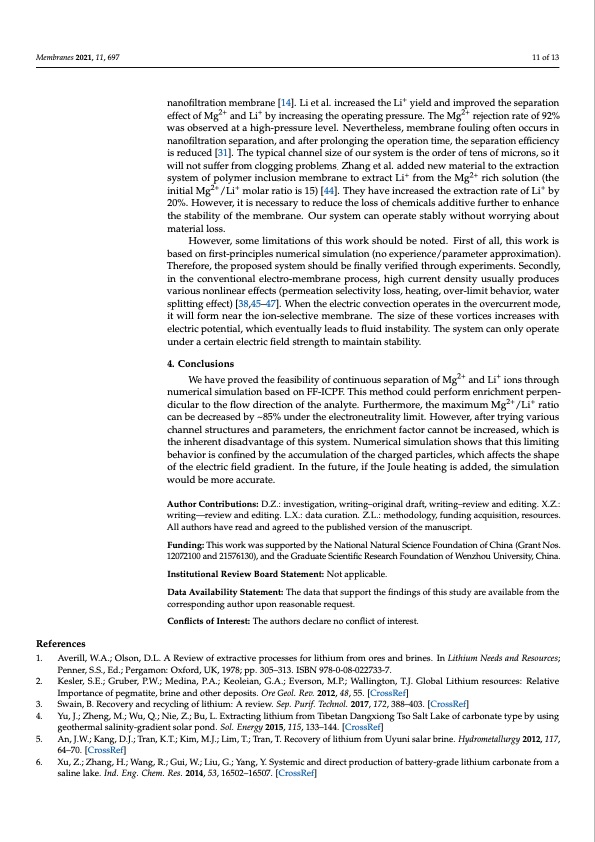
PDF Publication Title:
Text from PDF Page: 011
Membranes 2021, 11, 697 11 of 13 References nanofiltration membrane [14]. Li et al. increased the Li+ yield and improved the separation effect of Mg2+ and Li+ by increasing the operating pressure. The Mg2+ rejection rate of 92% was observed at a high-pressure level. Nevertheless, membrane fouling often occurs in nanofiltration separation, and after prolonging the operation time, the separation efficiency is reduced [31]. The typical channel size of our system is the order of tens of microns, so it will not suffer from clogging problems. Zhang et al. added new material to the extraction system of polymer inclusion membrane to extract Li+ from the Mg2+ rich solution (the initial Mg2+/Li+ molar ratio is 15) [44]. They have increased the extraction rate of Li+ by 20%. However, it is necessary to reduce the loss of chemicals additive further to enhance the stability of the membrane. Our system can operate stably without worrying about material loss. However, some limitations of this work should be noted. First of all, this work is based on first-principles numerical simulation (no experience/parameter approximation). Therefore, the proposed system should be finally verified through experiments. Secondly, in the conventional electro-membrane process, high current density usually produces various nonlinear effects (permeation selectivity loss, heating, over-limit behavior, water splitting effect) [38,45–47]. When the electric convection operates in the overcurrent mode, it will form near the ion-selective membrane. The size of these vortices increases with electric potential, which eventually leads to fluid instability. The system can only operate under a certain electric field strength to maintain stability. 4. Conclusions We have proved the feasibility of continuous separation of Mg2+ and Li+ ions through numerical simulation based on FF-ICPF. This method could perform enrichment perpen- dicular to the flow direction of the analyte. Furthermore, the maximum Mg2+/Li+ ratio can be decreased by ~85% under the electroneutrality limit. However, after trying various channel structures and parameters, the enrichment factor cannot be increased, which is the inherent disadvantage of this system. Numerical simulation shows that this limiting behavior is confined by the accumulation of the charged particles, which affects the shape of the electric field gradient. In the future, if the Joule heating is added, the simulation would be more accurate. Author Contributions: D.Z.: investigation, writing–original draft, writing–review and editing. X.Z.: writing—review and editing. L.X.: data curation. Z.L.: methodology, funding acquisition, resources. All authors have read and agreed to the published version of the manuscript. Funding: This work was supported by the National Natural Science Foundation of China (Grant Nos. 12072100 and 21576130), and the Graduate Scientific Research Foundation of Wenzhou University, China. Institutional Review Board Statement: Not applicable. Data Availability Statement: The data that support the findings of this study are available from the corresponding author upon reasonable request. Conflicts of Interest: The authors declare no conflict of interest. 1. Averill, W.A.; Olson, D.L. A Review of extractive processes for lithium from ores and brines. In Lithium Needs and Resources; Penner, S.S., Ed.; Pergamon: Oxford, UK, 1978; pp. 305–313. ISBN 978-0-08-022733-7. 2. Kesler, S.E.; Gruber, P.W.; Medina, P.A.; Keoleian, G.A.; Everson, M.P.; Wallington, T.J. Global Lithium resources: Relative Importance of pegmatite, brine and other deposits. Ore Geol. Rev. 2012, 48, 55. [CrossRef] 3. Swain, B. Recovery and recycling of lithium: A review. Sep. Purif. Technol. 2017, 172, 388–403. [CrossRef] 4. Yu, J.; Zheng, M.; Wu, Q.; Nie, Z.; Bu, L. Extracting lithium from Tibetan Dangxiong Tso Salt Lake of carbonate type by using geothermal salinity-gradient solar pond. Sol. Energy 2015, 115, 133–144. [CrossRef] 5. An, J.W.; Kang, D.J.; Tran, K.T.; Kim, M.J.; Lim, T.; Tran, T. Recovery of lithium from Uyuni salar brine. Hydrometallurgy 2012, 117, 64–70. [CrossRef] 6. Xu, Z.; Zhang, H.; Wang, R.; Gui, W.; Liu, G.; Yang, Y. Systemic and direct production of battery-grade lithium carbonate from a saline lake. Ind. Eng. Chem. Res. 2014, 53, 16502–16507. [CrossRef]PDF Image | Brines Based on Free Flow Ion Concentration Polarization

PDF Search Title:
Brines Based on Free Flow Ion Concentration PolarizationOriginal File Name Searched:
membranes-11-00697-v2.pdfDIY PDF Search: Google It | Yahoo | Bing
Product and Development Focus for Infinity Turbine
ORC Waste Heat Turbine and ORC System Build Plans: All turbine plans are $10,000 each. This allows you to build a system and then consider licensing for production after you have completed and tested a unit.Redox Flow Battery Technology: With the advent of the new USA tax credits for producing and selling batteries ($35/kW) we are focussing on a simple flow battery using shipping containers as the modular electrolyte storage units with tax credits up to $140,000 per system. Our main focus is on the salt battery. This battery can be used for both thermal and electrical storage applications. We call it the Cogeneration Battery or Cogen Battery. One project is converting salt (brine) based water conditioners to simultaneously produce power. In addition, there are many opportunities to extract Lithium from brine (salt lakes, groundwater, and producer water).Salt water or brine are huge sources for lithium. Most of the worlds lithium is acquired from a brine source. It's even in seawater in a low concentration. Brine is also a byproduct of huge powerplants, which can now use that as an electrolyte and a huge flow battery (which allows storage at the source).We welcome any business and equipment inquiries, as well as licensing our turbines for manufacturing.| CONTACT TEL: 608-238-6001 Email: greg@infinityturbine.com | RSS | AMP |